|
|
|
Sort Order |
|
|
|
Items / Page
|
|
|
|
|
|
|
| Srl | Item |
| 1 |
ID:
131970
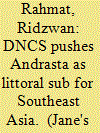

|
|
|
|
|
| Publication |
2014.
|
| Summary/Abstract |
French naval shipbuilding and systems groups DCNS is positioning its Andrasta compact submarine concept as a littoral patrol asset for Southeast Asian navies.
|
|
|
|
|
|
|
|
|
|
|
|
|
|
|
|
| 2 |
ID:
130066
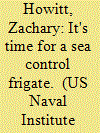

|
|
|
|
|
| Publication |
2014.
|
| Summary/Abstract |
A vessel based on the national security cutter could offer significant benefits to the Navy.
W hile O liver Hazard Perry- class frigates are not the only platforms you would want for a serious confrontation, they are great independent-deployers and effective at a multitude of missions such as escort operations and antisubmarine warfare (ASW). As the Navy decommissions the last 15 frigates, soon to be joined by 21 Ticonderoga- class cruisers, we will call on our existing hulls to support their ongoing missions. There is little doubt the littoral combat ship (LCS) fills some of this void, but even the top brass seem to agree that it's ineffective in a high-endurance, blue-water setting.
In January, a report from the Pentagon described a plan to cut the amount of LCSs from 52 to 32 ships, and in a leaked classified memo, Commander of Naval Surface Forces Vice Admiral Tom Copeman called for a new type of multi-mission ship. 1 Many envision a new combatant ship that incorporates air- and missile- defense radar and an electromagnetic railgun. While it is imperative that the Navy build these types of ships, a multibillion-dollar warship juggernaut is simply unnecessary when a new, cost-effective frigate could effectively accomplish the same missions.
Of the many potential frigate designs, Huntington Ingalls Industries offers one derived from its successful national security cutter (NSC) hull dubbed the "patrol frigate," originally intended and modeled for international navies. At first, it may seem preposterous to paint a Coast Guard cutter gray and call it a warship. In the July 2013 issue of Proceedings , Norman Polar opined that more frigates were needed, but was quick to dismiss a patrol frigate as a viable option. He claimed it "lacked growth potential and service life, as well as certain military features." 2 But tweaking the NSC could turn it into a viable candidate that meets the Navy's needs.
|
|
|
|
|
|
|
|
|
|
|
|
|
|
|
|
| 3 |
ID:
129860
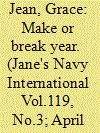

|
|
|
|
|
| Publication |
2014.
|
| Summary/Abstract |
Lead Littoral Combat Ship (LCS) USS freedom completed its maiden operational development in 2013. US future frigate plans may include a variation of the LCS design. Both LCS variants are in serial production. Despite all this, the US department of defence has announced the truncation of the programme.
|
|
|
|
|
|
|
|
|
|
|
|
|
|
|
|
| 4 |
ID:
130758
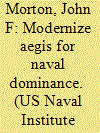

|
|
|
|
|
| Publication |
2014.
|
| Summary/Abstract |
Missile-defense capabilities on board U.S. Navy cruisers and destroyers can be updated in the future without the requirement to build new ships.
The surface Navy has a strong argument that the Department of Defense strategic guidance and the rapidly changing security environment fully support Aegis modernization plans. Modernized Aegis warships are critical naval assets for overseas commanders-even more so when cost-effectively upgraded with the capability for integrated air and missile defense (IAMD). Expedited deployment of this next-generation capability will boost near-term readiness and further solidify U.S. maritime dominance. Modernized Aegis warships are the combatant commanders' guarantors of globally integrated joint-force operations for joint access-the sharp edge of the nation's 21st-century deterrence policy.
|
|
|
|
|
|
|
|
|
|
|
|
|
|
|
|
| 5 |
ID:
124035
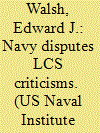

|
|
|
|
|
| Publication |
2012.
|
| Summary/Abstract |
The article reports that the U.S. Navy awarded funds to the prime contractors of its two shipbuilding initiatives, Lockheed Martin, and Austal USA LLC, including the Navy's Littoral Combat Ship (LCS) program for accessing the engineering and production challenges. It states that the Navy wants to build 55 ships by taking on and offloading various mission packages. It mentions that this may lead to the criticism of LCS shipbuilding and development of LCS mission packages.
|
|
|
|
|
|
|
|
|
|
|
|
|
|
|
|
| 6 |
ID:
130753
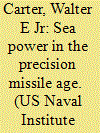

|
|
|
|
|
| Publication |
2014.
|
| Summary/Abstract |
In the hands of adversaries, long-range strike systems could drastically alter the conduct of war at sea.
The constant evolution of military technology has driven continuous change in the character of warfare, to the benefit of the militaries that adapt the most successfully. More than 70 years have passed since a major maritime conflict. During that time many new technologies have emerged, with few combat tests to provide reliable guideposts regarding what will prove successful now and in a future conflict.
|
|
|
|
|
|
|
|
|
|
|
|
|
|
|
|
| 7 |
ID:
130068


|
|
|
|
|
| Publication |
2014.
|
| Summary/Abstract |
The Independence -class littoral combat ship (LCS) has a fundamentally different design from any other ship in the Navy. Understanding how its design affects propulsion, sea-keeping, and reactions to external forces is critical to understanding how to drive it effectively, efficiently, and safely.
The Independence -class LCS is propelled by four steerable water jets (WJs) that have independent drive trains. The two outboard WJs, driven by motor turbine union 20-cylinder main propulsion diesel engines (MPDE) rated at 12,200 horse power (HP) each, have the most impact on low-speed precision maneuvering due to their position off centerline. The two inner WJs, used for high-speed operations and restricted maneuvering situations, are driven by LM2500 gas turbine engines, each with speeds up to 29,500 HP. The ship develops thrust as water is drawn through intakes under the hull, travels through each WJ tunnel, and is driven at high speed through the WJ by an impeller.
Attached to each WJ is a hydraulically actuated reversing plate commonly referred to as a "bucket," which controls the amount of water directed forward or aft. When the ship's control console (SCC) indicates zero percent bucket, roughly one-third of the water is directed astern and two-thirds are directed forward and down, causing the applied longitudinal forces to cancel out. Even at this "zero-thrust" point, the impellers are still turning at idle speed, an important consideration for the effects of engine wash on surrounding vessels and structures.
|
|
|
|
|
|
|
|
|
|
|
|
|
|
|
|
| 8 |
ID:
129181
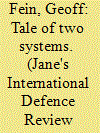

|
|
|
|
|
| Publication |
2014.
|
| Summary/Abstract |
In its fiscal year 2015 (FY 2015), budget, the US department of Defence (DoD) tasked the US navy (USN) with finding a replacement for the littoral combat ship (LCS) by the end of 2014. The new ship can be a new design or a modified version of LCS.
|
|
|
|
|
|
|
|
|
|
|
|
|
|
|
|
| 9 |
ID:
130759
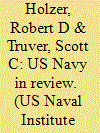

|
|
|
|
|
| Publication |
2014.
|
| Summary/Abstract |
"Over the last year, we were on station in the Pacific to deal with provocative North Korean actions," Chief of Naval Operations Admiral Jonathan Greenert wrote in his foreword to the Navy Program Guide 2014 . "We patrolled off the shores of Syria, Libya, Egypt, Somalia, and Sudan to protect American lives, hunt violent extremists, and induce regional leaders to make constructive choices amid widespread disorder. We delivered aid and relieved suffering in the Philippines in the wake of a devastating typhoon. We mobilized to restrain coercion against our allies and friends in the East and South China Seas. We kept piracy at bay in the Horn of Africa," he continued. "We projected long-range combat power from aircraft carriers in the North Arabian Sea into Afghanistan, and arrayed our forces to enhance stability in the Arabian Gulf. Across the Middle East and Africa, we took the fight to insurgents, terrorists, and their supporting networks by providing high leverage expeditionary support to Special Operations Forces."
|
|
|
|
|
|
|
|
|
|
|
|
|
|
|
|
| 10 |
ID:
131973
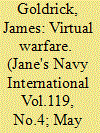

|
|
|
|
|
| Publication |
2014.
|
| Summary/Abstract |
As platforms, personnel and budgets reduce, navies are using more simulation in training. James Goldrick looks at how the Royal Australian Navy is increasing its use of simulation to balance commitments and resources.
|
|
|
|
|
|
|
|
|
|
|
|
|
|
|
|
|
|
|
|
|